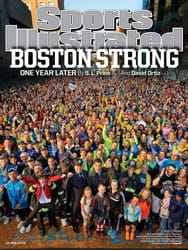
The Case for ... Jadeveon Clowney
SCOUTS AND TALENT evaluators differ on where South Carolina defensive end Jadeveon Clowney ranks among the best defensive prospects of the last decade, but even the most ardent skeptics believe he's one of the five best to enter the league in some time. Still, a handful of current and former NFL evaluators told SI that a top-tier quarterback will always be valued over a pass rusher, no matter how dominant the rusher promises to be. "If anyone in the room—definitely the head coach or GM—thinks that a QB can [get] the team into the playoffs, they're going to pick him," said one former scout.
History underscores this principle: In 2010, Sam Bradford was drafted ahead of Ndamukong Suh, unquestionably the top defensive prospect not named Clowney to have come out of college in the last few years. In 2011, Cam Newton was picked over Von Miller and Patrick Peterson even though both defensive players were higher-graded prospects and considered safer options. (Newton has become a star, but he was a high-risk, high-reward pick who would need time to develop.)
Brian Burke, founder of advancednflstats.com, created Win Percentage Added, or WPA, which to some degree replicates Wins Above Replacement in baseball. As the name suggests, WPA measures how much a player helped his team win games. From 2008 through '12, 72 players had a WPA above 2.0—an indicator of players with high impact. Twenty-five of those were defensive players; 27 were quarterbacks. In other words, defensive players can play as prominent a role as quarterbacks in winning games. More important, since there are 352 defensive starters but only 32 starting quarterbacks in the league at a given time, the numbers indicate that as a percentage of the total, it's more difficult to find a high-impact defensive player than a high-impact quarterback. So when one comes along, grab him.
That's especially true this year, when the quarterback class is average. Teams have cooled on Louisville's Teddy Bridgewater because at 6'2" he's a little small and he lacks elite arm strength. Texas A&M's Johnny Manziel might as well be one giant red flag, from his diminutive stature (6 feet) to his attitude to the perceived lack of structure in his game. Blake Bortles may have the most potential, but even his most optimistic fans—including George O'Leary, his coach at Central Florida—believe he'll need to fix some flaws in his mechanics before he can be a legitimate NFL starter.
Clowney, meanwhile, has the potential to be one of the best players not just in the league but also in his era. At the NFL combine the 6'6", 266-pound Clowney ran a 4.53 40-yard dash, an average time—for a cornerback. His measurables are more impressive than those of some current NFL stars (and athletic freaks) such as Rams defensive end Robert Quinn, Bills defensive end Mario Williams and Niners outside linebacker Aldon Smith.
Clowney's superlative sophomore season (13 sacks and 23½ tackles for loss) compares favorably with Smith's best year at Missouri (11½ sacks and 19 TFLs). And while Smith has been nearly unstoppable in the NFL, amassing 42 sacks in three seasons, Clowney has more natural talent, more polish, better college production and, by nearly all accounts, a higher ceiling.
The Texans own the top pick, and the risk for them is twofold: If they pass on Clowney for a quarterback, not only could they miss out on a game-changing player, but also he could fall to the Jaguars, a division rival with the No. 3 pick. Thus Clowney could spend the next decade terrorizing Houston's new quarterback.
If, on the other hand, the Texans were to pair Clowney with defensive end J.J. Watt, already among the best defensive players in football, suddenly Houston would have a front seven forged in the fires of an offensive coordinator's hell.
Height
6'6"
Weight
266
40-Yard Dash
4.53
Bench Reps
21
Vertical Jump
37½"
Broad Jump
10'4"
3-Cone Drill
7.27
PHOTO
SCOTT CUNNINGHAM FOR SPORTS ILLUSTRATED

